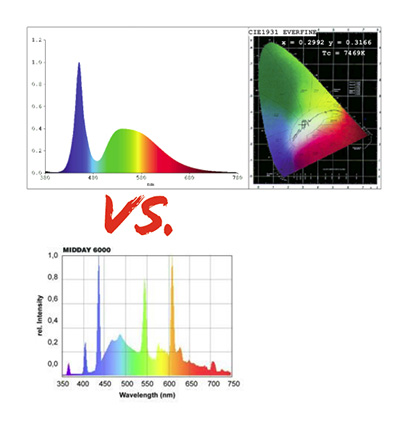Well just because the Ray 2 has higher PAR doesn't necessarily mean it's better (might be on a different application). The PAR from a Ray 2 on a semi-shallow tank like your 20g Long will be REALLY HIGH... so you're going to experience algae if you don't either suspend the fixture or run the light at a reduced photoperiod (this means less tank/fish viewing time for you). You'll also have to crank up that co2 too. Plus that really bright (blue heavy spectrum) is going to wash out the colors in your tank a bit... I'm talking from first-hand experience.. It's not totally bad or anything, but it's not the most appealing once you've experienced otherwise. Once I started using LED lights that supplement reds in it, I've noticed a better color production/reflection off of colorful plants and fish/inverts. Just looked more vibrant and dynamic -- not muted. It's up to you.. but that's my opinion.

With the Fugeray Planted+ , in terms of PAR, you'd get (
source):
9": 88
12": 61
Your tank is only 12" tall, minus a few inches of substrate, you're already in high light territory.
Dig around online, especially in TPT... you'll see others complain about the colors being washed-out and stale with just a Ray 2 (Some people are fine with it though, you might be?). After they supplemented the light with the Monster Ray (RGB LED), they liked it much better. So the Planted+ has the potential to do the same but as a stand-alone light without having to buy two fixtures as with what the Ray 2 + Monster Ray people are doing.
That's why Finnex developed this light as their "newest" version of the Ray fixtures. They are answering the call of the market analysis on how people are commenting on the color rendering of their tanks.
FYI... PAR is less on the Planted Plus because red light doesn't travel and penetrate as deep as the blue spectrum. That's another reason the Ray 2 has such a high PAR value... if you look at the spectrum analysis graph, it's heavy on the blue and lacking the "full spectrum" you'd get out of a T5HO. Blue can penetrate depths more easily. That's why when you SCUBA, everything looks really blue the deeper you go. Colorful fish and corals look monochromatic. LED is a new technology in terms of aquariums... they're learning new ways to utilize the technology more efficiently and effectively. Plants respond better when their is full spectrum availability. They'll grow with just blue spectrum but not as good (from what I've researched) when reds and greens are in there too... reds more so than green.
They probably don't add more reds to the Ray 2 because it would make the price-point less palatable for the consumers... is what I'm guessing.
Here's a spectral graph of the Ray 2 on the top... The bottom is a full spectrum T5HO midday bulb... notice the lack of red spike and green in the Ray 2? Although there's no spectral graph available with the Planted+ yet, I would assume that it has to be better in the red spectrum.
Take for instance the spectral graph released by Finnex of their small clip light called the Fugeray-R (R for Red)... It has that spike in the red:
Sorry for the long post... I guess I got carried away. It wasn't easy to answer that question.




